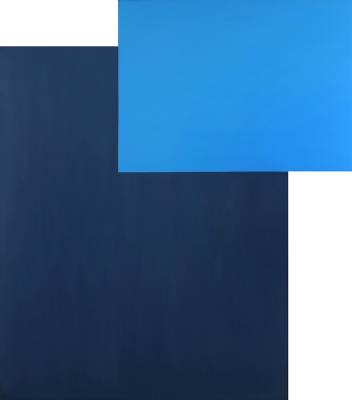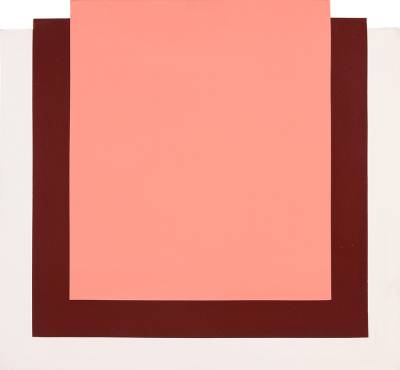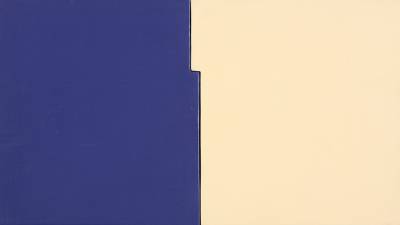„Eckenbilder / Corner pictures“ 1969 – 1970
 Josef Albers, Homage to the Square, 1954
Josef Albers, Homage to the Square, 1954Öl auf Masonite, 60 x 60 cm,
Josef Albers Museum Quadrat, Botrop
Even more clearly than in the "Schachtelbildern" Hans introduces us in the "Eckenbildern" the optical interaction of colors. Without any dividing lines, the completely homogeneous color areas lie side by side, revealing a change in their characteristics through the border areas. In spite of the same kind of color, our eye does not perceive this static factor. Rather a bright field next to a darker one seems to be even lighter and vice versa.
We experience this phenomenon in "Wegweiser" from 1969. The painting receives an increase of the optical illusion by the strongly outstanding upper rectangle, whose radiant light blue suggests us such a lightness, that we think it could 'fly away'.
As with this image, Hans - in contrast to Josef Albers, who limits his color interactions to the square image format - limits himself neither to the quadrat nor to the traditional quadrilateral. However, he often uses the polygon for the paintings of this period, with which he infuses the spatial component as a further irritation into his visual spectacle of color.
This also applies to "Entwurf für Hell-Dunkel", 1970. On the flat wooden board we find the interwoven surfaces - seen from bottom to top - beige, ox blood and salmon colors. We can see a staggering in view of the stepped upper edge of the picture. But if we take a closer look at the lower part of the picture, we soon get the impression that the sequence is made up of beige, ox blood and salmon colors.
While here the color fields are on a single ground, in "Entwurf für Violettes Blau-Beige" from the same year each color area is assigned its own board. They connect with each other through their polygonal form, which corresponds with their neighbor. Strongly connected at the back, the outer edges form a quadrilateral, the interaction takes place within these limits.
In many variations of two or three differently nested squares of the same or different tones, Hans feels the continuous inner movement of colors in the "Eckenbildern". In doing so, he impressively succeeds in creating the illusion of a visual truth, which at the same time encourages us to experience the work of art and to constantly re-create it ourselves.


